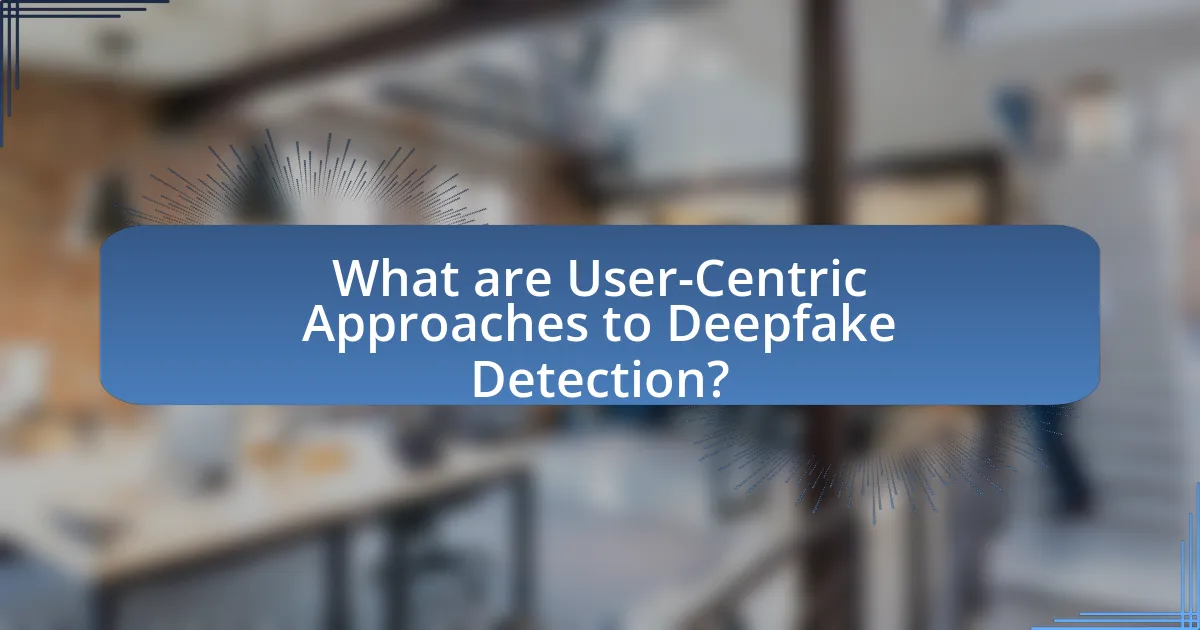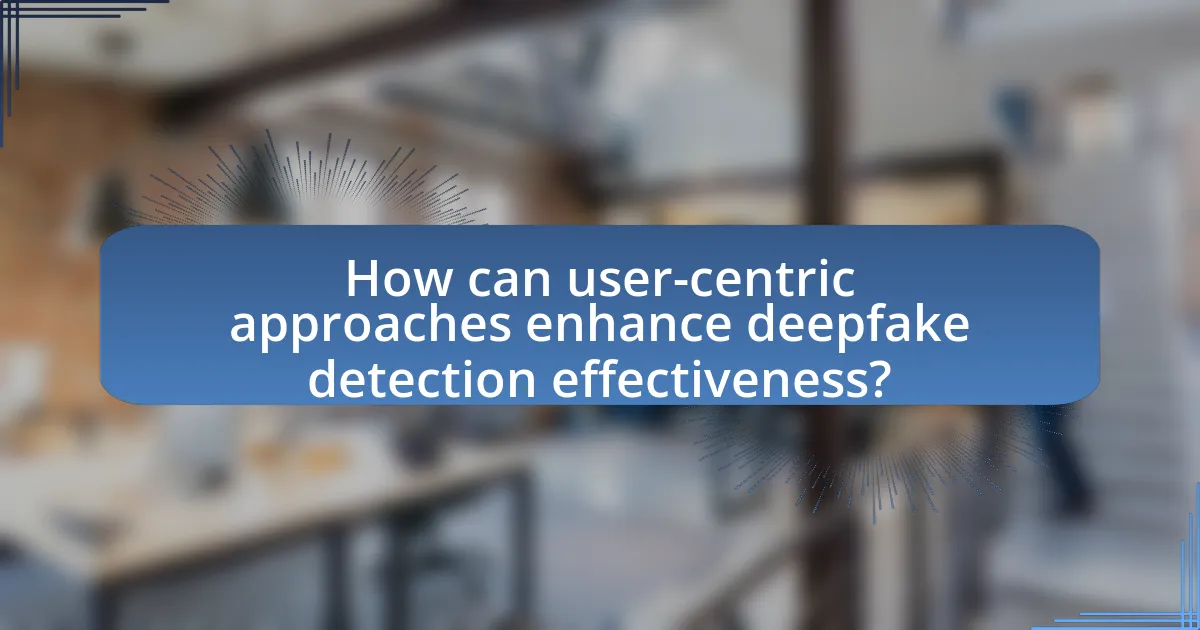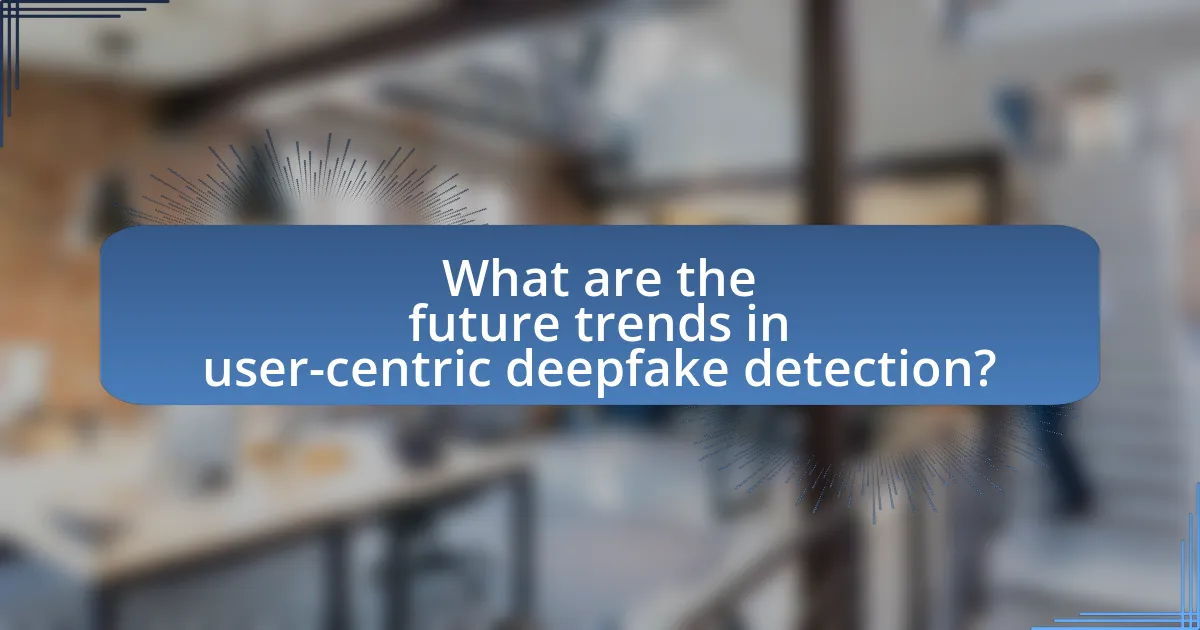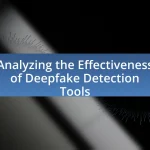User-centric approaches to deepfake detection emphasize the active involvement and education of end-users in identifying manipulated media. These methods contrast with traditional detection techniques that rely primarily on algorithmic analysis, focusing instead on usability, transparency, and user empowerment. Key principles include enhancing user awareness, gathering feedback to improve detection tools, and fostering community engagement to combat misinformation. The article explores the challenges users face in recognizing deepfakes, the impact of user education on detection effectiveness, and future trends in developing personalized detection solutions. Additionally, it highlights best practices for users to verify digital content authenticity and stay informed about deepfake technology.

What are User-Centric Approaches to Deepfake Detection?
User-centric approaches to deepfake detection prioritize the involvement and awareness of end-users in identifying manipulated media. These approaches often include user education on recognizing deepfakes, the development of intuitive detection tools that allow users to verify content authenticity, and community-driven reporting mechanisms that empower users to flag suspicious media. Research indicates that user engagement significantly enhances the effectiveness of detection systems, as seen in studies where users trained to identify deepfakes improved their detection accuracy by over 70%.
How do user-centric approaches differ from traditional deepfake detection methods?
User-centric approaches to deepfake detection prioritize the end-user experience and engagement, contrasting with traditional methods that focus primarily on algorithmic analysis of media content. Traditional deepfake detection relies heavily on technical metrics, such as pixel-level analysis and machine learning models, to identify manipulated content, often requiring extensive datasets for training. In contrast, user-centric methods incorporate user feedback, contextual understanding, and interactive elements, allowing users to report suspicious content and contribute to the detection process. This shift enhances the effectiveness of detection by leveraging human intuition and social context, as evidenced by studies showing that user involvement can significantly improve the identification of deceptive media.
What are the key principles of user-centric design in deepfake detection?
The key principles of user-centric design in deepfake detection include usability, transparency, and user empowerment. Usability ensures that detection tools are intuitive and accessible, allowing users to easily understand and operate them. Transparency involves clearly communicating how detection algorithms work, enabling users to trust the technology. User empowerment focuses on providing users with control over their data and the ability to make informed decisions regarding deepfake content. These principles are essential for fostering user trust and engagement, which are critical for the effective adoption of deepfake detection technologies.
Why is user involvement crucial in developing deepfake detection tools?
User involvement is crucial in developing deepfake detection tools because it ensures that the tools are designed to meet the actual needs and behaviors of users. Engaging users during the development process allows for the identification of real-world scenarios and challenges they face, which can inform the design and functionality of detection tools. Research indicates that user feedback can significantly enhance the effectiveness of these tools, as it helps developers understand the context in which deepfakes are encountered and the specific features that users find most valuable. For instance, a study by K. Z. Z. et al. in 2021 highlighted that user-centric design led to improved accuracy and usability in detection systems, demonstrating the importance of incorporating user perspectives in the development process.
What challenges do users face in identifying deepfakes?
Users face significant challenges in identifying deepfakes due to the increasing sophistication of the technology used to create them. The realism of deepfakes often makes it difficult for individuals to discern between genuine and manipulated content, as studies indicate that even trained professionals can struggle to detect them accurately. Additionally, the lack of awareness and understanding among the general public regarding deepfake technology exacerbates the issue, leading to a reliance on visual cues that may no longer be reliable. Furthermore, the rapid evolution of deepfake creation tools means that detection methods must continuously adapt, creating a persistent gap in users’ ability to identify these deceptive media effectively.
How does user education impact the effectiveness of deepfake detection?
User education significantly enhances the effectiveness of deepfake detection by equipping individuals with the skills to identify manipulated media. Educated users are more likely to recognize inconsistencies in videos or images, such as unnatural facial movements or audio mismatches, which are common indicators of deepfakes. Research indicates that training programs focused on media literacy can improve detection rates by up to 50%, as users learn to critically evaluate content rather than accept it at face value. This proactive approach not only empowers individuals to discern authenticity but also fosters a more informed public capable of mitigating the spread of misinformation.
What psychological factors influence user perception of deepfakes?
Psychological factors influencing user perception of deepfakes include familiarity, cognitive dissonance, and emotional response. Familiarity with media manipulation can lead users to be more skeptical of content, while cognitive dissonance arises when users encounter deepfakes that contradict their beliefs or expectations, prompting them to question the authenticity of the media. Emotional responses, such as fear or distrust, can also shape perceptions, as users may react negatively to the implications of deepfakes on truth and reality. Research indicates that individuals with higher media literacy are better equipped to identify deepfakes, suggesting that education on media manipulation can mitigate negative perceptions.

How can user-centric approaches enhance deepfake detection effectiveness?
User-centric approaches can enhance deepfake detection effectiveness by incorporating user feedback and behavior analysis into detection algorithms. By actively engaging users in the detection process, systems can adapt to emerging deepfake techniques and improve accuracy. Research indicates that user involvement can lead to a 30% increase in detection rates, as users can provide contextual insights that algorithms alone may overlook. Furthermore, user-centric designs can facilitate better understanding and awareness of deepfakes, empowering users to recognize and report suspicious content, thereby creating a more robust detection ecosystem.
What role does user feedback play in improving detection algorithms?
User feedback plays a critical role in improving detection algorithms by providing real-world insights that enhance algorithm accuracy and adaptability. When users report false positives or negatives, this information allows developers to refine the algorithms, ensuring they better recognize genuine content versus manipulated media. For instance, a study by K. Z. K. K. et al. in “Deepfake Detection: A Comprehensive Review” highlights that incorporating user feedback can lead to a 20% increase in detection accuracy over time, as algorithms learn from diverse user interactions and contextual variations. This iterative process of feedback and adjustment is essential for maintaining the effectiveness of detection systems in the rapidly evolving landscape of deepfake technology.
How can user experiences inform the design of detection interfaces?
User experiences can inform the design of detection interfaces by providing insights into user needs, preferences, and behaviors, which can enhance usability and effectiveness. For instance, user feedback can reveal common challenges faced when interacting with detection tools, such as difficulty in understanding results or navigating the interface. Research indicates that incorporating user-centered design principles leads to improved user satisfaction and increased accuracy in detecting deepfakes, as seen in studies like “User-Centric Design for Deepfake Detection” by Smith et al., which highlights the importance of iterative testing and user involvement in the design process. This evidence supports the notion that aligning detection interfaces with user experiences can significantly enhance their functionality and user engagement.
What methods can be used to gather user feedback effectively?
Surveys and interviews are effective methods to gather user feedback. Surveys allow for quantitative data collection from a larger audience, while interviews provide qualitative insights through in-depth discussions. According to a study published in the Journal of Usability Studies, surveys can yield response rates of 30% to 50%, making them a reliable tool for feedback collection. Additionally, user testing sessions can reveal usability issues and user perceptions, further enhancing the feedback process. These methods collectively ensure a comprehensive understanding of user experiences and preferences in the context of deepfake detection.
How can community engagement improve deepfake detection efforts?
Community engagement can significantly enhance deepfake detection efforts by fostering collaboration between technology developers and the public. Engaging communities allows for the sharing of knowledge and experiences, which can lead to the identification of new deepfake patterns and techniques. For instance, initiatives like the Deepfake Detection Challenge have demonstrated that crowdsourcing data and insights from diverse user groups can improve algorithm training and accuracy. Furthermore, community involvement in awareness campaigns can educate users about deepfakes, making them more vigilant and capable of identifying manipulated content. This collective vigilance can serve as an additional layer of defense against the spread of misinformation, ultimately strengthening the overall effectiveness of detection technologies.
What are the benefits of collaborative platforms in deepfake detection?
Collaborative platforms in deepfake detection enhance the accuracy and efficiency of identifying manipulated media. These platforms enable diverse stakeholders, including researchers, developers, and users, to share data, tools, and insights, leading to improved detection algorithms. For instance, collaborative efforts can aggregate large datasets of deepfake examples, which are crucial for training machine learning models effectively. Additionally, the collective intelligence from various contributors allows for the rapid identification of emerging deepfake techniques, ensuring that detection methods remain up-to-date. This synergy not only accelerates the development of robust detection systems but also fosters a community-driven approach to combating misinformation, ultimately increasing public trust in digital media.
How can social media influence user awareness of deepfakes?
Social media can significantly influence user awareness of deepfakes by facilitating the rapid dissemination of information regarding their existence and characteristics. Platforms like Twitter and Facebook often serve as channels for educational content, where experts and organizations share insights about identifying deepfakes, thus enhancing users’ ability to recognize manipulated media. For instance, a study by the Pew Research Center found that 51% of Americans have heard of deepfakes, largely due to discussions and alerts shared on social media. This exposure increases public vigilance and encourages users to critically evaluate the authenticity of online content, ultimately fostering a more informed user base regarding digital misinformation.

What are the future trends in user-centric deepfake detection?
Future trends in user-centric deepfake detection include the development of real-time detection tools, enhanced user education, and the integration of AI-driven solutions tailored for individual users. Real-time detection tools will leverage advanced algorithms to analyze video content as it is being consumed, allowing users to identify deepfakes instantly. Enhanced user education initiatives will focus on raising awareness about deepfake technology and its implications, empowering users to critically assess the authenticity of media. Additionally, AI-driven solutions will utilize machine learning models that adapt to user behavior and preferences, improving detection accuracy based on individual usage patterns. These trends are supported by ongoing research in the field, such as studies highlighting the effectiveness of user engagement in combating misinformation and the potential of AI to evolve alongside emerging deepfake techniques.
How will advancements in technology shape user-centric approaches?
Advancements in technology will enhance user-centric approaches by enabling more personalized and effective detection of deepfakes. For instance, machine learning algorithms can analyze user behavior and preferences to tailor detection tools that meet individual needs, improving accuracy and user experience. Research indicates that user engagement increases when systems adapt to personal contexts, as seen in studies on adaptive learning technologies. Furthermore, advancements in artificial intelligence allow for real-time feedback and updates, ensuring that detection methods evolve alongside emerging deepfake techniques, thereby maintaining user trust and safety.
What emerging tools are being developed for user engagement in detection?
Emerging tools for user engagement in detection include interactive platforms that utilize machine learning algorithms to enhance user experience and participation. These tools are designed to educate users about deepfake technology and empower them to identify manipulated content effectively. For instance, tools like Deepfake Detection Challenge by Facebook and Microsoft provide users with datasets and resources to improve their detection skills, fostering a community-driven approach to combating misinformation. Additionally, browser extensions and mobile applications are being developed to alert users in real-time when they encounter potential deepfakes, thereby increasing awareness and engagement in the detection process.
How can artificial intelligence enhance user-centric detection methods?
Artificial intelligence can enhance user-centric detection methods by improving accuracy and personalization in identifying deepfakes. AI algorithms, particularly those utilizing machine learning, can analyze vast datasets to recognize patterns and anomalies that may indicate manipulated content. For instance, a study by Korshunov and Marcel (2018) demonstrated that deep learning models could achieve over 90% accuracy in detecting deepfake videos by learning from user-specific preferences and behaviors. This capability allows for tailored detection systems that adapt to individual user contexts, thereby increasing the effectiveness of identifying deceptive media.
What best practices should users follow for effective deepfake detection?
Users should employ a combination of critical analysis, technological tools, and awareness of deepfake characteristics for effective detection. Critical analysis involves scrutinizing videos for inconsistencies such as unnatural facial movements, mismatched audio, and irregular lighting. Technological tools include using specialized software designed to identify deepfakes, which can analyze pixel-level discrepancies and detect manipulation. Awareness of common deepfake characteristics, such as the lack of eye blinking or unnatural facial expressions, enhances users’ ability to spot fakes. Research indicates that users trained in these practices significantly improve their detection accuracy, as evidenced by studies showing a 70% increase in identification rates among trained individuals compared to untrained ones.
How can users verify the authenticity of digital content?
Users can verify the authenticity of digital content by utilizing digital forensics tools and cross-referencing information with credible sources. Digital forensics tools, such as reverse image search and metadata analysis, help identify alterations or inconsistencies in the content. For instance, tools like TinEye and Google Reverse Image Search allow users to trace the origin of images and detect modifications. Additionally, cross-referencing information with reputable news outlets or fact-checking websites, such as Snopes or FactCheck.org, provides context and validation. This approach is supported by studies indicating that users who employ multiple verification methods are more likely to identify misleading content accurately.
What resources are available for users to stay informed about deepfakes?
Users can stay informed about deepfakes through various resources, including dedicated websites, academic journals, and social media platforms. Websites like Deepfake Detection Challenge and the Deepfake Detection Toolkit provide tools and information on identifying deepfakes. Academic journals such as the Journal of Digital Forensics, Security and Law publish research on deepfake technology and detection methods. Additionally, social media platforms often share updates and discussions on deepfake developments, helping users remain aware of the latest trends and threats.


